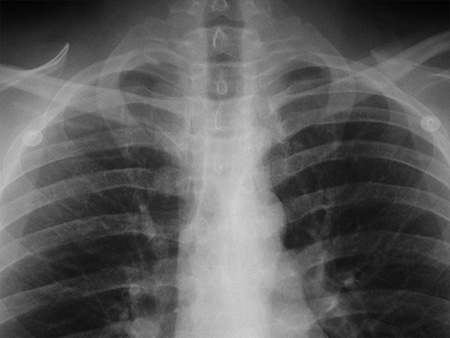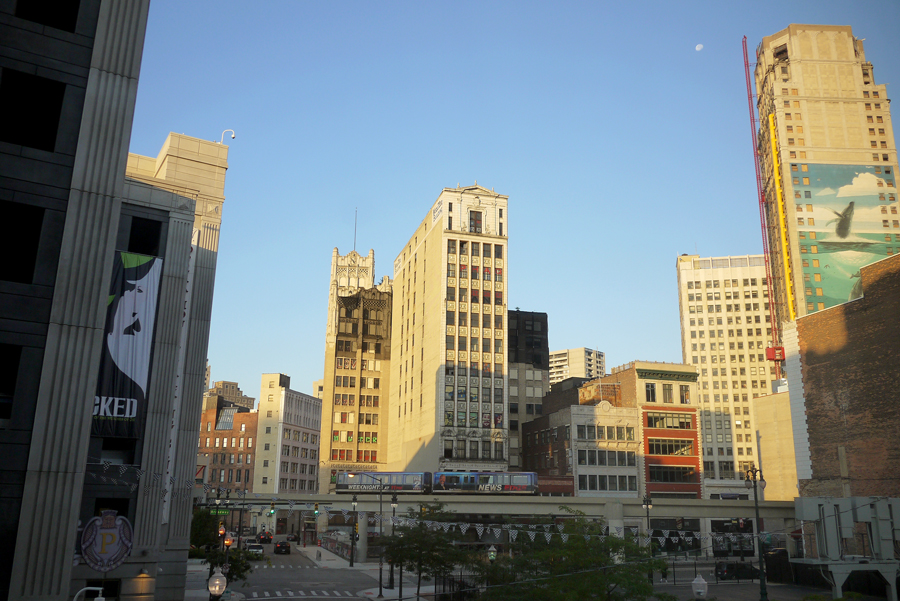Afraid to See the Doctor: Public Hospitals Struggle to Provide Care for the Uninsured
This article first appeared in Faultlines, the printed newspaper of San Francisco Indymedia, Feburary 2005.
It’s common knowledge that health care for the uninsured in the United States is in a perpetual state of crisis. My interest in the public heath care system began out of pure need. During a pick-up soccer game at Golden Gate Park, I was cut on the top side of my ankle from another player’s spiked cleats. The wound broke the surface of the skin, but it wasn’t that painful at first. Since I had no insurance, I decided to treat it myself. I limped to a friend’s house, washed out the wound, put on some antiseptic cream, wrapped it in a bandage, and thought that was that.
Three weeks later, my entire foot was so swollen that I couldn’t fit it in my shoe. Despite my best efforts to keep it clean and germ-free, what had once been a superficial cut had become a nasty, purple, oozing, and extremely painful infection. I couldn’t walk, I couldn’t ride my bike, I couldn’t go to work. My foot became my world, as the pain drowned out all other cares and interests. Desperate, tortured, and hurting, but afraid of costly doctor bills, I first sought homeopathic, natural methods of healing. I was embarrassed by my own inability to stave off germs, and ended up not even showing the woman at the herbal remedies store my foot, for fear that she would shoo me off and tell me to see a doctor. The potions they gave me failed to make anything better. With the condition of my sorry looking appendage growing increasingly worrisome, I decided that I needed help fast, so I got a friend to give me a ride to San Francisco General Hospital.
Two years ago, I was part of the growing number of Americans without medical insurance. In 2004, the Census Bureau counted 44 million uninsured Americans, two million more than in 2002. The Lewis Group, a private health-consulting firm, estimated that nearly 82 million Americans went without health insurance at some point during the past two years. With more Americans working service industry jobs that rarely provide insurance, increasing numbers simply go without this crucial safety net. Since most people without insurance don’t see a doctor on a regular basis, we put off seeking medial attention until we must. By waiting, treatable, preventable diseases can become life threatening. But in a medical system that is based on profits over patient health, preventive medicine for the uninsured is a misnomer. After all, one visit to the doctor can cost hundreds or thousands of dollars. It’s little wonder why the uninsured avoid professional health care.
The result is a “duel-system,” where the wealthy can get extravagant treatments for the most mundane of ailments, and the poor risk their heath or their jobs to seek care. There are some, albeit limited, resources available. Public hospitals are under legal and ethical obligations to treat anyone who is in need, regardless of their ability to pay. But my infected foot experience soon taught me that the uninsured pay for this minimal care with their time, at the very least. In my case, I spoke with a nurse, told her my financial information, and saw the doctor — after eight agonizing hours of waiting. I was grateful for the free examination, but the waiting room felt like an endless purgatory, and this was my first encounter with this medical limbo. There are millions of seriously ill people who spend much of their unfortunate lives withering in these lines.
And because private hospitals and clinics can decline to treat non-emergency patients, the limited resources to the uninsured available at public hospitals are continually stressed. Overworked staff and limited budgets translate into hours of waiting to see a doctor. Public hospitals are the last resort of the most disenfranchised — drug addicts, alcoholics and the mentally ill. In these cases, doctors and nurses have to play additional roles of social workers, above and beyond providing medical care.
“It’s a complex problem,” said Dr. Josh Gitter, a physician at Highland General, the public hospital serving Alameda County. “Doctors are serving multiple roles. Our first obligation is to provide the best medical care we can to our patients.” He was quick to note that despite the difficulties faced by public hospitals, triage, the system of ordering care provided to patients based on need, does insure emergency care for those who need it most urgently. He continued, “But when our patients’ social situations prevent us from providing the best of care, doctors take on additional roles of social workers. And public hospitals are stretched thin when it comes to providing essential social services.”
There is a huge disconnect between the need among our nation’s sick and the level of service our public health institutions are able to provide. Fortunately, our national heath care system, heavily saturated in corporate interests and layers of bureaucracy, is not the only way. Single-payer systems, such as those in Canada and Europe, allow for the access to high-quality care free of the fear of soaring medical bills. Certainly these systems are not free from abuse and corruption, nor financial constrains. Germany’s heath care system faced a multi-billion euro deficit thanks to an aging population needing more care and excessive, extravagant treatments. Even so, when compared to the American system, most of the developed world has better care for cheaper available to the poor. Advocates of a single-payer system in the United States, which would entail medical providers billing the government for all incurred expenses, estimate that overall savings in administrative costs could be up to 25 percent, amounting to billions of dollars.
One country to learn from is Cuba, which has developed one of the best medical system for a country at its level of development, despite facing extremely limited resources due to the American imposed embargo. Because they lack access to a high quantity of advanced medical equipment and medicines, the nation has adopted preventative care as a national policy. Cubans are encouraged to see their doctor (free of chare, of course) when they first get sick, allowing many diseases to be caught in the early stages. Despite Cuba’s extremely limited public health care budget, life expectancy is higher than in some parts of the United States. Cuba has also invested heavily in biotechnology, producing vaccines for diseases that are more prevalent in the developing world. Clearly, it doesn’t take an abundance of money to provide quality care, only making patient care a priority over profits.
Since it’s doubtful that the United States will see a single-payer medical system anytime soon, it’s vital that Americans demand access to health care through whatever avenues available. The mishmash of public services that do exist is fragile and prone to ever threatening budget cuts. After seeing the fifty or so patients waiting six or more hours to see a single doctor, I know how stressed the system is. Thankfully, after two weeks of antibiotics, I was up and walking again. While I’m grateful to the staff of San Francisco General for their help, this whole painful situation could have been avoided if, like many Americans, I hadn’t been so fearful of hospital bills.
Related posts:
4 Responses to “Afraid to See the Doctor: Public Hospitals Struggle to Provide Care for the Uninsured”
Leave a Reply
In my opinion, there are two stories above. The first one is obviously the debate on whether or not the US system is the right way to go? On the face of it, having that many uninsured people who can’t afford to seek proper medical care ends up being just a burden to society and most likely a net loss to everyone in economical terms.
However, countries with what my American friends call “socialised medicine” aren’t having an easy time of providing universal quality care either. Health care costs lots, no matter if it’s privatised or state run, and many treatments deemed non-urgent (which ends up being a moving target depending on how much the budget was overshot last year) are only available in commercial clinics/hospitals.
Some countries also introduce “user pays” charges for visiting doctors, filling prescriptions, outpatient treatment at hospitals and even ambulance travel. I don’t think there’s a clear-cut answer to this issue currently, but it seems to me that the pharmaceuticals and medical supplies companies deserve more scrutiny for what they charge and make available to health care providers.
The second story is the homeopathy. It really should set off alarm bells if the uninsured resort to completely un-tested and un-proven “natural therapies” which are quite simply modern day quackery. You were probably lucky not to lose your leg in fact…
Romanticizing the Cuban health care system is no answer. The Cuban system has developed as it has due to the failure of the Communist government to provide basic services to its citizens. Castro’s cult of personality has been a disaster for Cuba and this is a clear example.
Medical care cannot be really free. You complain about the poor having to spend time waiting as if that is an offense. Everyone must pay something for a benefit and this same poor person would expect to receive first class, effective care for their ills. I doubt this would be provided by the Cuban practicioner or any Third World, sociallist medical system.
In short, in order to have a free medical system, we would have to lower our expectations of quality medical care. People do not want to take the responsibility for taking care of themselves, your situation is a case in point. Therefore in order to maintain at least a pretense of medical equality, the system will have to struggle on in a manner at least much like we have now.
pls i need to see a doctor for respiratory infection but i dont have an insurance
Dear Josh… If you are the Josh Gitter who is my son’s friend, ( Kris Dunn). Please write me at the e-mail above or call me at 850-570-4294 , as Kris has told us very little about his condition … and we are , of course, very concerned.. He is extremely depressed and each day speaks of the unspeakable… Please contact me or Mr. Dunn at gdunn@emo-arc.com, or 850-570-4295, so we can help him decide on a plan of action…. I am relying on you to help us help our son whom we love and adore… Many thanks in advance for your concern… Sincerely yours, Judi and Gerry Dunn at this point do not tell hem we contacted you, as this would make him furious…





 Magical Urbanism, a website about urbanization, design and social change, is maintained by Mike Ernst. I'm an urban planner and designer based in New York City. I graduated from the
Magical Urbanism, a website about urbanization, design and social change, is maintained by Mike Ernst. I'm an urban planner and designer based in New York City. I graduated from the 










In my opinion, there are two stories above. The first one is obviously the debate on whether or not the US system is the right way to go? On the face of it, having that many uninsured people who can’t afford to seek proper medical care ends up being just a burden to society and most likely a net loss to everyone in economical terms.
However, countries with what my American friends call “socialised medicine” aren’t having an easy time of providing universal quality care either. Health care costs lots, no matter if it’s privatised or state run, and many treatments deemed non-urgent (which ends up being a moving target depending on how much the budget was overshot last year) are only available in commercial clinics/hospitals.
Some countries also introduce “user pays” charges for visiting doctors, filling prescriptions, outpatient treatment at hospitals and even ambulance travel. I don’t think there’s a clear-cut answer to this issue currently, but it seems to me that the pharmaceuticals and medical supplies companies deserve more scrutiny for what they charge and make available to health care providers.
The second story is the homeopathy. It really should set off alarm bells if the uninsured resort to completely un-tested and un-proven “natural therapies” which are quite simply modern day quackery. You were probably lucky not to lose your leg in fact…
Romanticizing the Cuban health care system is no answer. The Cuban system has developed as it has due to the failure of the Communist government to provide basic services to its citizens. Castro’s cult of personality has been a disaster for Cuba and this is a clear example.
Medical care cannot be really free. You complain about the poor having to spend time waiting as if that is an offense. Everyone must pay something for a benefit and this same poor person would expect to receive first class, effective care for their ills. I doubt this would be provided by the Cuban practicioner or any Third World, sociallist medical system.
In short, in order to have a free medical system, we would have to lower our expectations of quality medical care. People do not want to take the responsibility for taking care of themselves, your situation is a case in point. Therefore in order to maintain at least a pretense of medical equality, the system will have to struggle on in a manner at least much like we have now.
pls i need to see a doctor for respiratory infection but i dont have an insurance
Dear Josh… If you are the Josh Gitter who is my son’s friend, ( Kris Dunn). Please write me at the e-mail above or call me at 850-570-4294 , as Kris has told us very little about his condition … and we are , of course, very concerned.. He is extremely depressed and each day speaks of the unspeakable… Please contact me or Mr. Dunn at gdunn@emo-arc.com, or 850-570-4295, so we can help him decide on a plan of action…. I am relying on you to help us help our son whom we love and adore… Many thanks in advance for your concern… Sincerely yours, Judi and Gerry Dunn at this point do not tell hem we contacted you, as this would make him furious…